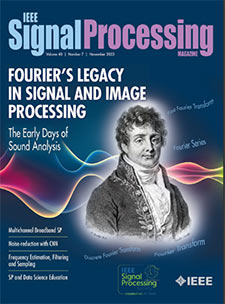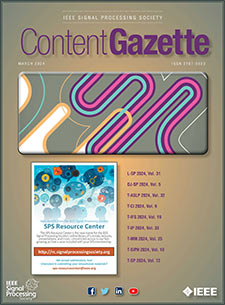- Our Story
- Publications & Resources
- Publications & Resources
- Publications
- IEEE Signal Processing Magazine
- IEEE Journal of Selected Topics in Signal Processing
- IEEE Signal Processing Letters
- IEEE/ACM Transactions on Audio Speech and Language Processing
- IEEE Transactions on Computational Imaging
- IEEE Transactions on Image Processing
- IEEE Transactions on Information Forensics and Security
- IEEE Transactions on Multimedia
- IEEE Transactions on Signal and Information Processing over Networks
- IEEE Transactions on Signal Processing
- IEEE TCI
- IEEE TSIPN
- Data & Challenges
- Submit Manuscript
- Guidelines
- Information for Authors
- Special Issue Deadlines
- Overview Articles
- Top Accessed Articles
- SPS Newsletter
- SigPort
- SPS Resource Center
- Publications Feedback
- Publications FAQ
- Blog
- News
- Dataset Papers
- Conferences & Events
- Community & Involvement
- Professional Development
- For Volunteers
- Information for Authors-OJSP
-
Home
Conferences Events IEEE JSTSP Article IEEE Signal Processing Magazine IEEE TIFS Article IEEE TMM Article IEEE TSP Article Jobs in Signal Processing Lectures Machine Learning Seasonal Schools Signal Processing News SPM Article SPS Distinguished Lectures SPS Newsletter Article SPS Webinar SPS Webinars SPS Webinar Series Webinar webinars
-
Our Story
What is Signal Processing?

The technology we use, and even rely on, in our everyday lives –computers, radios, video, cell phones – is enabled by signal processing. Learn More » -
Publications & Resources
-
SPS Resources
- Signal Processing Magazine The premier publication of the society.
- SPS Newsletter Monthly updates in Signal Processing
- SPS Resource Center Online library of tutorials, lectures, and presentations.
- SigPort Online repository for reports, papers, and more.
- SPS Feed The latest news, events, and more from the world of Signal Processing.
-
SPS Resources
-
Conferences & Events
-
Community & Involvement
-
Membership
- Join SPS The IEEE Signal Processing Magazine, Conference, Discounts, Awards, Collaborations, and more!
- Chapter Locator Find your local chapter and connect with fellow industry professionals, academics and students
- Women in Signal Processing Networking and engagement opportunities for women across signal processing disciplines
- Students Scholarships, conference discounts, travel grants, SP Cup, VIP Cup, 5-MICC
- Young Professionals Career development opportunities, networking
- Get Involved
-
Technical Committees
- Applied Signal Processing Systems
- Audio and Acoustic Signal Processing
- Bio Imaging and Signal Processing
- Computational Imaging
- Image Video and Multidimensional Signal Processing
- Information Forensics and Security
- Machine Learning for Signal Processing
- Multimedia Signal Processing
- Sensor Array and Multichannel
- Signal Processing for Communication and Networking
- Signal Processing Theory and Methods
- Speech and Language Processing
- Technical Working Groups
- More TC Resources
-
Membership
-
Professional Development
-
Professional Development
- Mentoring Experiences for Underrepresented Young Researchers (ME-UYR)
- Micro Mentoring Experience Program (MiME)
- Distinguished Lecturer Program
- Distinguished Lecturers
- Distinguished Lecturer Nominations
- Past Lecturers
- Distinguished Industry Speaker Program
- Distinguished Industry Speakers
- Distinguished Industry Speaker Nominations
- Industry Resources
- IEEE Training Materials
- Jobs in Signal Processing: IEEE Job Site
-
Career Resources
- SPS Education Program Educational content in signal processing and related fields.
- Distinguished Lecturer Program Chapters have access to educators and authors in the fields of Signal Processing
- PROGRESS Initiative Promoting diversity in the field of signal processing.
- Job Opportunities Signal Processing and Technical Committee specific job opportunities
- Job Submission Form Employers may submit opportunities in the area of Signal Processing.
-
Professional Development
-
For Volunteers
-
For Board & Committee Members
- Board Agenda/Minutes* Agendas, minutes and supporting documentation for Board and Committee Members
- SPS Directory* Directory of volunteers, society and division directory for Board and Committee Members.
- Membership Development Reports* Insight into the Society’s month-over-month and year-over-year growths and declines for Board and Committee Members
-
For Board & Committee Members
Popular Pages
Today's:
- Submit a Manuscript
- Information for Authors
- Signal Processing Cup
- (ICASSP 2024) 2024 IEEE International Conference on Acoustics, Speech and Signal Processing
- IEEE Transactions on Multimedia
- (SLT 2024) 2024 IEEE Spoken Language Technology Workshop
- IEEE Transactions on Image Processing
- (ICASSP 2025) 2025 IEEE International Conference on Acoustics, Speech and Signal Processing
- IEEE/ACM Transactions on Audio Speech and Language Processing
- IEEE Signal Processing Letters
- (MLSP 2024) 2024 IEEE International Workshop on Machine Learning for Signal Processing
- Signal Processing 101
- IEEE Transactions on Information Forensics and Security
- SPS Scholarship Program
- Award Recipients
All time:
- Information for Authors
- Submit a Manuscript
- IEEE Transactions on Image Processing
- 404 Page
- IEEE/ACM Transactions on Audio Speech and Language Processing
- IEEE Transactions on Information Forensics and Security
- IEEE Transactions on Multimedia
- IEEE Signal Processing Letters
- IEEE Transactions on Signal Processing
- Conferences & Events
- IEEE Journal of Selected Topics in Signal Processing
- Information for Authors-SPL
- Conference Call for Papers
- Signal Processing 101
- IEEE Signal Processing Magazine
Last viewed:
- Distinguished Lecturers
- (ICASSP 2025) 2025 IEEE International Conference on Acoustics, Speech and Signal Processing
- IEEE SPM Special Issue on Near-Field Signal Processing: Communications, Sensing and Imaging
- (RadarConf 2020) 2020 IEEE Radar Conference
- Distinguished Lecturer Program
- Information for Authors-SPL
- Signal Processing Cup
- (MLSP 2024) 2024 IEEE International Workshop on Machine Learning for Signal Processing
- Call for Proposals: IEEE ASRU 2025
- Understanding High Voltage Power Systems Through Signal Processing Technology
- Call For Proposals: IEEE ICME 2025
- Awards & Submit Award Nomination
- 3 Reasons Why Signal Processing is the Career of the Future
- Recent Contest in Signal Processing and Machine Learning
- Call For Proposals: IEEE ISBI 2025
Matthew C. Stamm (University of Maryland) “Digital multimedia forensics and anti-forensics”, 2012
You are here
Newsletter Menu
Newsletter Categories
Top Reasons to Join SPS Today!
1. IEEE Signal Processing Magazine
2. Signal Processing Digital Library*
3. Inside Signal Processing Newsletter
4. SPS Resource Center
5. Career advancement & recognition
6. Discounts on conferences and publications
7. Professional networking
8. Communities for students, young professionals, and women
9. Volunteer opportunities
10. Coming soon! PDH/CEU credits
Click here to learn more.
News and Resources for Members of the IEEE Signal Processing Society
Matthew C. Stamm (University of Maryland) “Digital multimedia forensics and anti-forensics”, 2012
Matthew C. Stamm (University of Maryland) “Digital multimedia forensics and anti-forensics”, Advisor: Prof. K. J. Ray Liu, 2012
As the use of digital multimedia content such as images and video has increased, so have the means and the incentive to create digital forgeries. Presently, powerful editing software allows forgers to create perceptually convincing digital forgeries. Accordingly, there is a great need for techniques capable of authenticating digital multimedia content. In response to this, researchers have begun developing digital forensic techniques capable of identifying digital forgeries. These forensic techniques operate by detecting imperceptible traces left by editing operations in digital multimedia content.
In this dissertation, the author proposed several new digital forensic techniques to detect evidence of editing in digital multimedia content. The thesis began by identifying the fingerprints left by pixel value mappings and showed how these can be used to detect the use of contrast enhancement in images. The author used these fingerprints to perform a number of additional forensic tasks such as identifying cut-and-paste forgeries, detecting the addition of noise to previously JPEG compressed images, and estimating the contrast enhancement mapping used to alter an image. Additionally, the problem of multimedia security was considered from the forger's point of view. It was demonstrated that an intelligent forger can design anti-forensic operations to hide editing fingerprints and fool forensic techniques. The author proposed an anti-forensic technique to remove compression fingerprints from digital images and showed that this technique can be used to fool several state-of-the-art forensic algorithms. Then, the author examined the problem of detecting frame deletion in digital video and developed both a technique to detect frame deletion and an anti-forensic technique to hide frame deletion fingerprints. It was showed that this anti-forensic operation leaves behind fingerprints of its own. The author developed a game theoretic framework to analyze this interplay and identify the set of actions that each party will rationally choose. Additionally, the author showed that anti-forensics can be used protect against reverse engineering.
For details, please contact the author or visit the thesis page.
Open Calls
Society News
New Books
Research Opportunities
Initiatives & Trends
Conference News
Education & Resources
TC News
SPS on Twitter
- DEADLINE EXTENDED: The 2023 IEEE International Workshop on Machine Learning for Signal Processing is now accepting… https://t.co/NLH2u19a3y
- ONE MONTH OUT! We are celebrating the inaugural SPS Day on 2 June, honoring the date the Society was established in… https://t.co/V6Z3wKGK1O
- The new SPS Scholarship Program welcomes applications from students interested in pursuing signal processing educat… https://t.co/0aYPMDSWDj
- CALL FOR PAPERS: The IEEE Journal of Selected Topics in Signal Processing is now seeking submissions for a Special… https://t.co/NPCGrSjQbh
- Test your knowledge of signal processing history with our April trivia! Our 75th anniversary celebration continues:… https://t.co/4xal7voFER
Home | Sitemap | Contact | Accessibility | Nondiscrimination Policy | IEEE Ethics Reporting | IEEE Privacy Policy | Terms | Feedback
© Copyright 2024 IEEE – All rights reserved. Use of this website signifies your agreement to the IEEE Terms and Conditions.
A not-for-profit organization, IEEE is the world's largest technical professional organization dedicated to advancing technology for the benefit of humanity.








